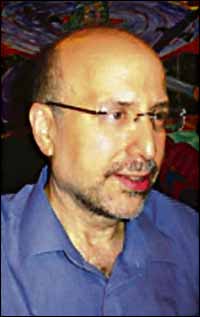|
PROFILE Nathan haunted by his uncle's 'missing face' | |
AS a young boy, professor of neurosurgery, Dr Nathan Moskowitz was haunted by an old photo which his Holocaust survivor father had shown him.
His father, Leib Moskowitz, had found the picture trampled on the floor when he returned to his Czechoslovakian home in Kuzmino after liberation from Mauthausen concentration camp. The picture showed his father, aged about 12, with his mother and elder brother, Herman who died a month before the camp was liberated. But the picture found in his totally ransacked home was partly defaced. Herman's face could not be seen. "It was like a puzzle," Nathan said. "I always wanted to know what my uncle looked like." The professor of neurosurgery became intrigued by visualisation, publishing a book, The Colour of Prophecy - Visualising the Bible in a New Light, which contained 18 paintings interpreting the stories of the latter prophets, accompanied by Nathan's Midrashic explanations of his visualisation. He is now working on a similar book, visually interpreting the Judges. But still the missing face of his uncle Herman continued to haunt Nathan until about seven or eight years ago when he was on the Yad Vashem website, researching family members, who had died in the Holocaust. He found his uncle's Mauthausen prisoner card. The card contained a lot of details, including Herman's age and place of birth. There was one column on the card that described all Herman's physical characteristics, how tall he was, the colour of his eyes, his hair, the shape of his face, his ears, the fact that his nose was broken and that he had a scar. Nathan told me: "When I read all that I really fell off my chair. Wow! They visually described my uncle. I now know what my uncle looked like. I did a forensic reconstruction and several paintings of him. "I thought that was a great idea. If I can do this, there are 300,000 Mauthausen cards. I figured this would make a great Holocaust project for high school students to download the cards and draw pictures. I formed a Shoah Forensic Art Institute for high school kids to memorialise concentration camp inmates, called Project Ezekiel." Then just over a year ago, Nathan was inspired, with the help of a portrait artist, to do a final painting of the family picture which had intrigued him for so long and create the front cover of a book about his Holocaust survivor parents' lives. Nathan's parents, Leib and Gittel Moskowitz, were then turning 85, living in the Bronx. Nathan felt the couple, who were in good health with excellent memories, had a duty to tell their stories for posterity to counteract Holocaust denial. Kuzmino Chronicles - Memoirs of Teenage Holocaust Survival, published by the Shoah Forensic Art Institute, not only tells their fascinating stories, but accompanies these with factual details and documentation to prove the authenticity of their experiences. Nathan said: "You get a personal view of Holocaust from just two people, who were in gamut of concentration camps. "This is not a routine memoir. It has historical information which correlates with the stories, giving them a lot of context." For British readers, the story of Nathan's mother is of special interest because she spent time in Belfast, Manchester, Burnley and London before emigrating to America, where she married Leib, who hailed from her hometown of Kuzmino, Czechoslovakia. The only member of her family of eight children to survive, Gittel, who had been in Auschwitz, Ravensbruck and Malchow, went back to her home in Kuzmino to find it was occupied by one of her neighbours. Registering with the Prague Jewish Society, she was told that Britain was willing to take 100 orphan survivors, 50 boys and 50 girls. Meeting the criteria, Gittel arrived in Belfast in 1946 and went to the Millisle settlement farm there. In his book, Nathan lists the refugees who were in the Belfast refugee farm. During the six months she was there, Gittel was taught not only English, but also all about Judaism - a lot of which she had forgotten. From there she was sent to Manchester, to stay with four other girls with a family of German Jews. Nathan said: "All my mother could remember from Manchester was that every day she had to help clean the dishes for these 'Yekkes'." From Manchester, Gittel was sent to Burnley Community College, being shunted around from family to family to hostel. Nathan said: "They taught her to design clothes and cook. When I was growing up I found a little biology notebook with drawings of different parts of the teeth. "I was very impressed, she had a very beautiful handwriting. I think she was given a pretty good general education. She was a very good student. "They wanted her to stay on and do more. But they gave her the choice. Ultimately from Burnley. she landed up in London, where she worked in a factory to work. But it was made clear to Gittel that her stay in Britain could only be temporary and before Rosh Hashana 1950 she arrived in New York on the Queen Mary. Meanwhile Leib, after receiving death threats in Kuzmino had gone to an uncle in Sudetenland. But with the fall of the Iron Curtain, he was smuggled by the Bricha - a Zionist group which smuggled 200,000-300,000 post-war Holocaust survivors into then-Palestine through a variety of routes - into an American displaced persons camp in Gabersee, Germany, where he stayed for four to five years, before being sponsored by an uncle in America.
|
